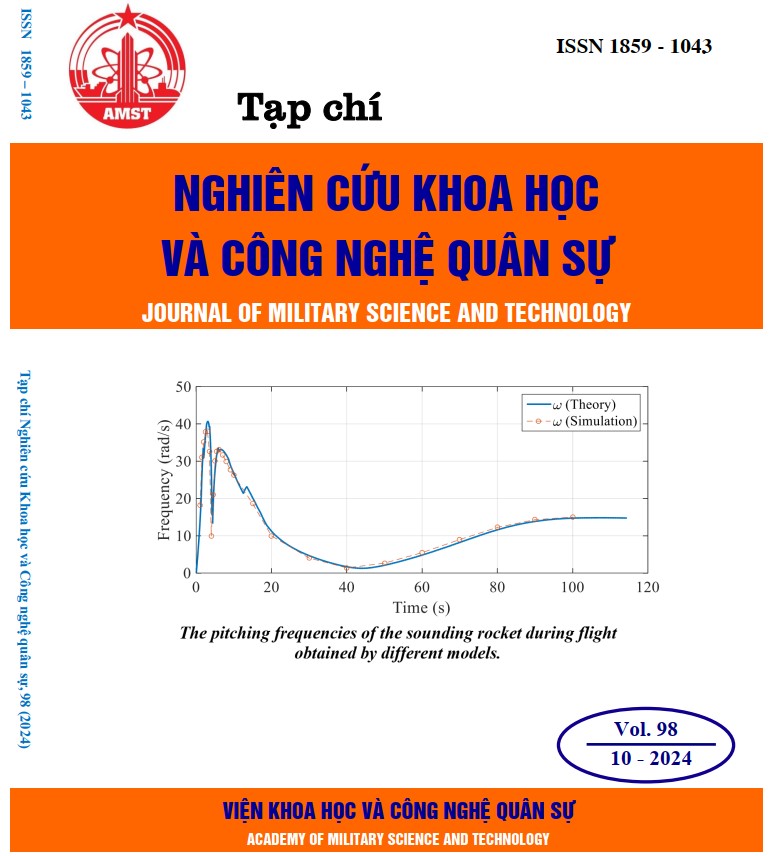Study on the treatment of landfill leachate using FeSO4.7H2O/NaOCl for Reactive Oxygen Species generation
394 viewsDOI:
https://doi.org/10.54939/1859-1043.j.mst.98.2024.109-115Keywords:
Leachate; Reactive Oxygen Species; ROS.Abstract
Leachate treatment is an urgent issue due to the high concentration of pollutants, which are difficult to treat using traditional technologies. Recently, reactive oxygen species (ROS) generating systems have been studied for potential applications. This paper presents the research results on the leachate treatment capability of the FeSO₄·7H₂O/NaOCl system. The study shows that the FeSO₄·7H₂O/NaOCl ROS-generating system is effective in treating leachate, reducing COD by nearly 80%, TDS by 71.2%, and changing the water color from dark black to light brown, while eliminating foul odors after 30 minutes of reaction at room temperature, pH = 6.9.
References
[1]. Lê Thanh Sơn và cộng sự, “Nghiên cứu, thử nghiệm khả năng xử lý nước rỉ rác bằng quá trình keo tụ điện hóa”, Tạp chí hoạt động KHCN An toàn - Sức khỏe & Môi trường lao động, Số 4,5&6, (2017).
[2]. Đào Duy Khánh và cộng sự, “Nghiên cứu xử lý màu và COD trong nước thải dệt nhuộm bằng giải pháp AOPs/UV kết hợp tiền xử lý keo tụ”, Tạp chí Nghiên cứu Khoa học và Công nghệ quân sự, số 86, trang 86-94, (2023). DOI: https://doi.org/10.54939/1859-1043.j.mst.86.2023.86-94
[3]. J. Shanthi Sravan, Leonidas Matsaka, Omprakash Sarkar, “Advances in biological wastewater treatment processes: Focus on low-carbon energy and resource recovery in biorefinery context”, Bioengineering, Vol. 11, pp. 281, (2024). DOI: https://doi.org/10.3390/bioengineering11030281
[4]. Naef A. A. Qasem, Ramy H. Mohammed, D.U. Lawal, “Removal of heavy metal ions from wastewater: a comprehensive and critical review”, NBJ Clean Water, Vol. 36, pp. 1-15 (2021).
[5]. Wang, L., et al, "Sedimentation and flotation in wastewater treatment", Journal of Environmental Management, Vol. 4, pp. 46-54, (2021).
[6]. Trương Quý Tùng và cộng sự, “Xử lý nước rỉ rác bằng tác nhân UV-Fenton trong thiết bị gián đoạn”. Tạp chí Khoa học Đại học Huế, số 53, trang 165-175, (2009).
[7]. Nguyễn Thị Ngọc Bích, Đặng Xuân Hiển. “Nghiên cứu so sánh khả năng xử lý nước rỉ rác bằng phương pháp oxy hóa bằng O3 và oxy hóa tiên tiến (AOPs)”. Tạp chí Khoa học và Công nghệ Lâm nghiệp, số 4, trang 15-20, (2013).
[8]. Van Huu Tap, Trinh Van Tuyen, Dang Xuan Hien. “Treatment of leachate by combining PAC and UV/O3 processes”, Journal of Vietnamese Environment, Vol. 3, pp. 38-42, (2012). DOI: https://doi.org/10.13141/jve.vol3.no1.pp38-42
[9]. Lê Hoàng Việt, Nguyễn Võ Châu Ngân, Giáo trình Kỹ thuật xử lý nước thải. NXB ĐH Cần Thơ, (2014).
[10]. Meng-hui Zhang, Hui Dong, Liang Zhao, De-xi Wang, Di Meng. “A review on Fenton process for organic wastewater treatment based on optimization perspective”, Science of the Total Environment, Vol. 670, pp. 110-121, (2019).
[11]. Mohd Salim Mahtaba, Izharul Haq Farooqia, Anwar Khursheedb, “Sustainable approaches to the Fenton process for wastewater treatment: A review”, Materials Today: Proceedings, Vol. 47, pp. 1480-1484, (2021). DOI: https://doi.org/10.1016/j.matpr.2021.04.215
[12]. M.S. Mahtab, D.T. Islam, I.H. Farooqi, “Optimization of the process variables for landfill leachate treatment using Fenton based advanced oxydation technique”, Eng. Sci. Technol. Int., Vol. 24, pp. 428-435, (2021). DOI: https://doi.org/10.1016/j.jestch.2020.08.013
[13]. M.H. Zhang et al., “A review on Fenton process for organic wastewater treatment based on optimization perspective”, Sci. Total Environ., Vol. 670, pp. 110–-121, (2019). DOI: https://doi.org/10.1016/j.scitotenv.2019.03.180
[14]. D. Ghernaout, N. Elboughdiri, S. Ghareba, “Fenton technology for wastewater treatment: dares and trends”, Open Access Library J., Vol. 7 (1), pp. 1-26, (2020). DOI: https://doi.org/10.4236/oalib.1106045
[15]. S. Kesar, M. S. Bhatti, “Chlorination of secondary treated wastewater with sodium hypochlorite (NaOCl): An effective single alternate to other disinfectants”, Heliyon, Vol. 8, e11162, (2022). DOI: https://doi.org/10.1016/j.heliyon.2022.e11162
[16]. Bộ Khoa học và Công nghệ, “TCVN 6491:1999- Tiêu chuẩn Việt Nam về chất lượng nước, xác định nhu cầu oxy hóa học”, (1999).







